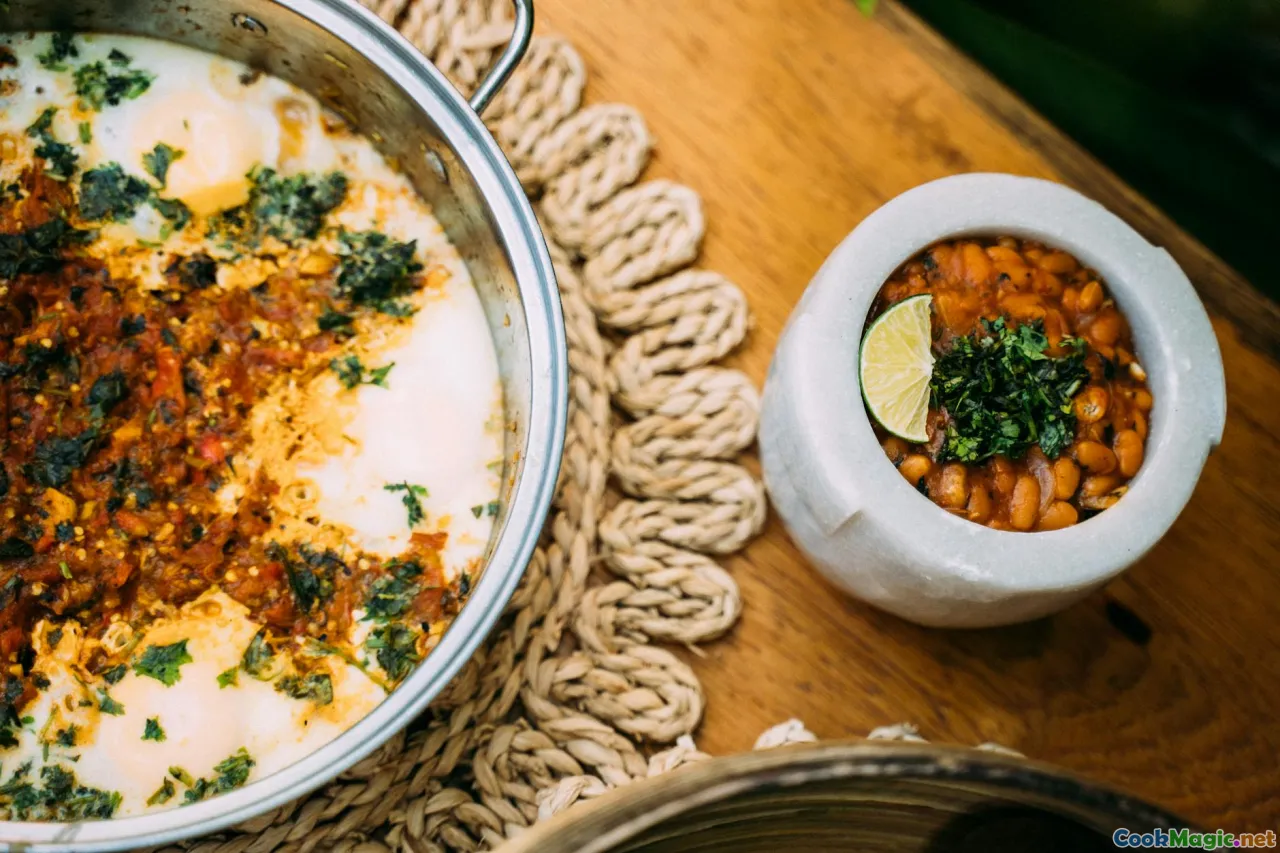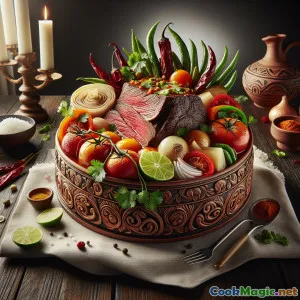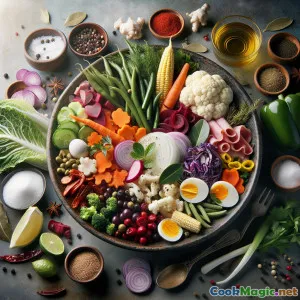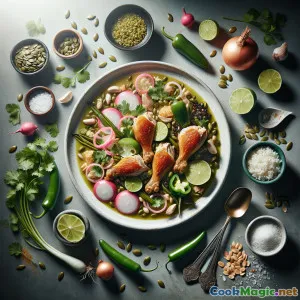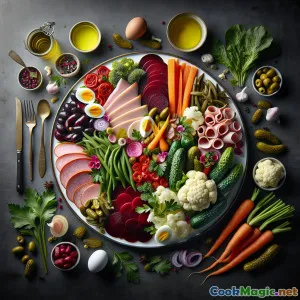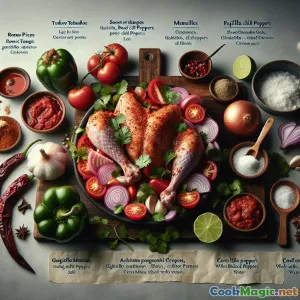
Дымный суп Как'ик: Острая индюшиная рагу из Гватемалы
(Smoky Kak'ik Soup: Guatemala's Spicy Turkey Stew)
(0 Обзоры)0
1,308
июль 15, 2025
Сообщить о проблеме
Ингредиенты
-
1.2 kg Куски индейки (ноги, бедра, крылья)
(Куски с кожей или целая небольшая индейка, очищенная)
-
4 medium Помидоры Рома
(Свежий, спелый)
-
3 medium Томатильо
(Очистил и промыл)
-
1 large Сладкий красный болгарский перец
(Крупно нарезанный)
-
2 tbsp Паста из ачиоте
(Для насыщенного цвета и земляного вкуса)
-
2 whole Гвахи́льо перцы чили
(Без косточек и стеблей)
-
1 whole Пасилья чили
(Без косточек и стеблей)
-
6 whole Чесночные зубчики
(Очистил)
-
1 large Белый лук
(Измельченный)
-
1 bunch Кинза
(Отложите немного листьев для украшения)
-
1 small handful Мята
(Предпочтительно местная 'херба буэна')
-
5 pieces Целые ягоды душистого перца
(Опционально, добавляет теплые нотки)
-
4 tbsp Кукурузное тесто
(Для загустения или замены кукурузной муки)
-
6 pieces Дольки лайма
(Для подачи)
-
2 tsp Соль
(По вкусу)
-
1 tsp Целый черный перец
(Свежо разбитое)
-
2.5 liters Вода
(Домашний бульон из индейки или курицы, если есть)
(Куски с кожей или целая небольшая индейка, очищенная)
(Свежий, спелый)
(Очистил и промыл)
(Крупно нарезанный)
(Для насыщенного цвета и земляного вкуса)
(Без косточек и стеблей)
(Без косточек и стеблей)
(Очистил)
(Измельченный)
(Отложите немного листьев для украшения)
(Предпочтительно местная 'херба буэна')
(Опционально, добавляет теплые нотки)
(Для загустения или замены кукурузной муки)
(Для подачи)
(По вкусу)
(Свежо разбитое)
(Домашний бульон из индейки или курицы, если есть)
Питательная ценность
- Порции: 6
- Размер порции: 1 большая миска (~350 мл)
- Calories: 450 kcal
- Carbohydrates: 0 g
- Protein: 57 g
- Fat: 15 g
- Fiber: 6 g
- Sugar: 7 g
- Sodium: 780 mg
- Cholesterol: 125 mg
- Calcium: 78 mg
- Iron: 3.2 mg
Инструкции
-
1 - Подготовка перцев и овощей:
Легко обжарьте на горячей сухой сковороде (comal) гуахильо и пасилья чили до появления ароматного запаха, но не дайте им сгореть. Снимите с огня и замочите в тёплой воде на 10 минут до смягчения.
-
2 - Ароматические специи для пассировки:
На той же горячей сковороде обжарьте помидоры, томатилло, чеснок, лук и болгарский перец до хорошего обгорания и легкого подгорания, при необходимости переворачивая для равномерной обжарки. Снимите с огня и отложите.
-
3 - Смешайте основу:
В блендере смешайте размягчённые перцы, поджаренные овощи, пасту ачиоте, чёрный перец, душистый перец (если используете) и 1 стакан воды. Взбейте до очень гладкой и густой пасты.
-
4 - Обжарить индейку до золотистого цвета:
В большой тяжелой кастрюле разогрейте немного масла. Обжарьте куски индейки со всех сторон до получения насыщенного вкуса. При необходимости удалите лишний жир.
-
5 - Тушить индейку:
Добавьте смесь из измельченного чили в кастрюлю с индейкой. Влейте оставшуюся воду (или бульон). Посолите. Доведите до кипения, уменьшите огонь и варите под крышкой 60 минут, пока индейка не станет мягкой, а бульон не приобретет насыщенный цвет.
-
6 - Добавить травы и тесто:
Смешайте кукурузную муку с небольшим количеством бульона до получения однородной гладкой кашицы. Добавьте кориандр, мяту и смесь муки в суп. Тушите на слабом огне еще 10 минут, чтобы немного загустеть и насытить ароматами.
-
7 - Украшение и Подавание:
Проверьте соль и при необходимости отрегулируйте. Подавайте горячий суп в больших мисках — каждый с щедрым кусочком индейки, большим количеством бульона, свежей кинзой и долькой лайма для выжимания.
Легко обжарьте на горячей сухой сковороде (comal) гуахильо и пасилья чили до появления ароматного запаха, но не дайте им сгореть. Снимите с огня и замочите в тёплой воде на 10 минут до смягчения.
На той же горячей сковороде обжарьте помидоры, томатилло, чеснок, лук и болгарский перец до хорошего обгорания и легкого подгорания, при необходимости переворачивая для равномерной обжарки. Снимите с огня и отложите.
В блендере смешайте размягчённые перцы, поджаренные овощи, пасту ачиоте, чёрный перец, душистый перец (если используете) и 1 стакан воды. Взбейте до очень гладкой и густой пасты.
В большой тяжелой кастрюле разогрейте немного масла. Обжарьте куски индейки со всех сторон до получения насыщенного вкуса. При необходимости удалите лишний жир.
Добавьте смесь из измельченного чили в кастрюлю с индейкой. Влейте оставшуюся воду (или бульон). Посолите. Доведите до кипения, уменьшите огонь и варите под крышкой 60 минут, пока индейка не станет мягкой, а бульон не приобретет насыщенный цвет.
Смешайте кукурузную муку с небольшим количеством бульона до получения однородной гладкой кашицы. Добавьте кориандр, мяту и смесь муки в суп. Тушите на слабом огне еще 10 минут, чтобы немного загустеть и насытить ароматами.
Проверьте соль и при необходимости отрегулируйте. Подавайте горячий суп в больших мисках — каждый с щедрым кусочком индейки, большим количеством бульона, свежей кинзой и долькой лайма для выжимания.
Подробнее о: Дымный суп Как'ик: Острая индюшиная рагу из Гватемалы
Kak'ik de Quetzaltenango: A Fiery, Aromatic Classic from the Guatemalan Highlands
Kak'ik is one of the jewels of Guatemalan cuisine, perched proudly on tables during family celebrations and festive occasions in the country’s western highlands, especially around Quetzaltenango (also called Xela). At first glance, it appears to be a simple “turkey stew,” but unpacking a single bowl reveals the rich history, vibrant ingredients, and stubborn Mayan traditions that have survived centuries of change.
Historical & Cultural Significance
Kak'ik (pronounced kahk-eek) traces its roots to the ancient Mayan people, who settled in Guatemala well before the Spanish conquest. The name itself derives from the Q’eqchi’ Mayan language: 'kak' meaning “red” and 'ik' meaning “hot, or spicy.” Although now spread across many regions, it remains particularly meaningful in Quetzaltenango, where indigenous Cakchiquel and Mam communities craft their brothy staple much as their ancestors once did—wood-fire, clay pots, and all.
Traditionally, Kak’ik uses wild turkey or 'chompipe,' an animal with deep ritual and culinary value. The bright scarlet color, imparted by heaps of luscious ripe tomatoes, annatto (achiote), and chilis, recalls strength and sacrifice.
What Makes This Version Unique?
- Layered Smokiness: Step one is the subtle toasting and charring of chilis and vegetables, a classic Mayan technique lending unparalleled depth.
- Aromatic Thickeners: By swirling masa (corn dough) in at the end, the broth gains a pleasing, silky body, echoing Guatemalan tortillas. This version uses fresh cilantro and native mint—bold and fragrant.
- Rustic Presentation: Each bowl boasts a meaty turkey chunk surrounded by a sunset-red broth, sometimes eaten with 'tamales de masa' or simple white rice on the side.
Substitutes, Serving, and Tips
- Use chicken if turkey is unavailable, but the wilder gaminess of turkey is more traditional and flavorful.
- Toltec and Mayan recipes use native 'hierba santa' instead of mint—seek it out for a truly authentic fragrance.
- Adjust chili quantity for a milder or feistier soup.
- Leftovers can be refrigerated up to 3 days; flavors deepen substantially overnight.
Perfect Pairings
Guatemalan corn tortillas or a classic rice side (‘arroz blanco’) turn Kak’ik into a hearty main. For festivals, locals pour it into large bowls and gather family together—every bite is connective, memorable.
Personal Thoughts
Cooking Kak'ik is like traveling in both time and place. The scents—spicy, smoky, and green—waft through the kitchen, teaching patience and respect for Maya culinary ritual. Many Guatemalan cooks say, “A soup isn’t ready until it’s shared.”
So treat Kak'ik de Quetzaltenango as more than a weekend culinary project; see it as a stew layered with history, community, and flavor. Whether you're seeking warmth, a taste of Central America, or the magic of Mayan food technology, this recipe is your gateway to a singular, spicy tradition.

